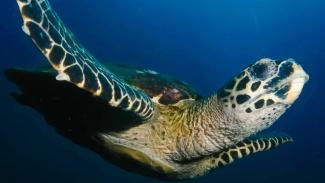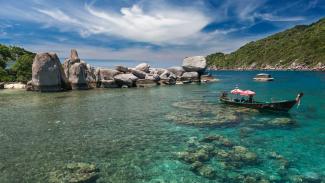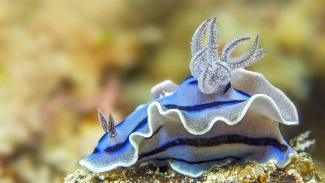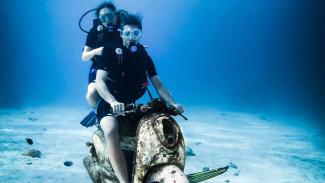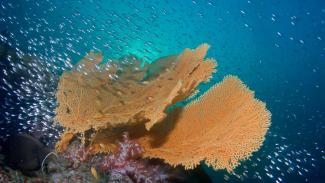Our guide to the best dive sites in Cebu
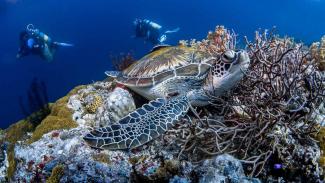
Cebu is the most accessible island in the Visayas, and home to some wonderful scuba diving.
Diving Malapascua is a thrill for more advanced divers due to regular sightings of Thresher Sharks. Oslob, to the south of Cebu City is famous for whale sharks, while you can dive on beautiful coral reefs in Moalboal or Mactan Island.
This is a great area for island-hopping, combining well with Bohol and Negros Islands.
Highlights
Best diving spots
Mactan Island
Mactan Island, just to the east of Cebu City, is the most easily reached scuba diving destination in Cebu. The east of the island drops into a deep, narrow channel that brings plenty of nutrients and enjoyable dives.
Marigondon and Pang Pang are wall dives, where divers drift in the current and admire the colourful corals and sponges that cling to the walls. Large Gorgonians are a feature of these sites and Marigondon has a large field of Garden Eels.
Looking for the latest liveaboard deals in the Philippines? Find your deal
In between these two sites is a large cave at 26m that experienced divers can visit. It is home to curious Flashlight Fish that use bioluminescence to attract their prey in the darkness. Further to the north, the wall becomes a gentle slope. Across the deep channel is Olango Island. This has a couple of good sites, with a nice drop-off at Santa Rosa and the chance to see Sharks and other larger species around Baring.
Oslob
Oslob, south of Cebu City has sprung to fame in recent years as a destination to dive with or swim with Whale Sharks. Sightings are very consistent, with a relationship between the local fishermen and Whale Sharks. Oslob can be visited with diving from Moalboal or Mactan Island, and also features on some liveaboard itineraries.
Moalboal
On the western coast of Cebu is Moalboal. The star of the Moalboal area is Pescador Island. This small island has a huge variety of marine life and very interesting topography. The Cathedral is a funnel-shaped cave pierced by the sun’s rays. The shallow fringing reef gives way to an impressive drop-off, where Whitetip Reef Sharks and sometimes Hammerheads can be seen. Very occasionally, Threshers & Tiger Sharks are spotted too. Numerous colourful reef-fish call this island home and Spanish Dancers are sometimes spotted floating along the reef.
Badian Island is another good site, while for experienced divers, the deep sea-mound of Lambung is a great place to find large schools of fish & plenty of action in the blue, including Manta Rays. There is also good shore diving from the beach around Moalboal.
Malapascua
Just off the north coast of Cebu Island, Malapascua has excellent diving. More advanced divers flock to Monad Shoal, otherwise known as Shark Point. As the name suggests, this is a great spot to find Sharks. Beautiful, elusive Thresher Sharks are frequent visitors to this underwater plateau, as are Silvertip Sharks and even Manta Rays. The site is quite deep, starting at 18 metres, so is not recommended for beginners. It is one of the best places in the world to dive with Thresher Sharks.
Capitancillo Island has an excellent wall dive. Again, this is a pretty good spot for Manta Rays, as well as Tuna & large Groupers. The reef here is teeming with life. Kimod Reef is another good spot for larger sightings, including several Shark species, Eagle Rays & Mantas. Quatro Island has beautiful coral gardens and interesting caves to explore.
Gato Island has an unusual tunnel going right under the island. Whitetip Reef Sharks are common, both in and out of the tunnel. The site has plentiful soft corals, plus good macro life.
Sumilon Marine Park
In the far south of Cebu, Sumilon has more excellent diving. The Philippines’ first marine park has gin-clear water, plummeting drop-offs, huge gorgonians and occasionally pelagic species.
When to dive
The best time to dive Cebu is between October and May, but the area offers excellent scuba diving year round. June to September can be more humid, but the area remains enjoyable. The area lies in the Typhoon Belt, meaning there is a risk of Typhoons from June to November, but it is far enough south that this is rare.
Getting there
The best way to reach Cebu is to fly to Cebu Mactan Airport, which has flights from both domestic and international destinations. From here, it is relatively easy to reach the island's major dive bases. Mactan is only a short drive away, while Moalboal can be reached in around 90 minutes. Malapascua Island is a longer journey by road to the north of the main island and then a short boat ride. For those looking to island hop, there are also ferry connections with Bohol Island and Negros Oriental.
Activities
The main activities are scuba diving, snorkelling and enjoying the beautiful beaches. It is also possible to try other water sports or simply explore the area. There are plenty of nice restaurants and bars, but the atmosphere is generally laidback rather than lively.
Resort and liveaboard options
There are resort options in all the good diving areas around Cebu Island, with plenty of choice available. Some of the best value options are in Malapascua, but there are excellent dive resorts and accommodation options in Moalboal & Mactan as well.
To see the much more of the region on one trip, some choose a liveaboard itinerary of the Visayas islands departing from Cebu City.
Liveaboards in Cebu
Whatever your budget, liveaboards represent a superb way to dive Cebu and her neighboring islands. While liveaboards might represent a higher upfront costs, generally accommodation, all meals and a large number of dives are included.
Itineraries vary in length from 6 to 11 nights, generally leaving from and returning to Cebu. Some itineraries take in the southern region including Moalboal, Sumilon and Oslob. Southern Visayas liveaboards also focus on the dive sites of Dauin and eastern Bohol.
Other itineraries head north to take in Malapascua, generally instead of Dauin, also visiting Bohol and dive sites on the eastern side of Cebu Island. There are also itineraries available that combine Malapascua with the dive sites of Southern Leyte.
Longer itineraries tour the entire region, taking in Dumaguete (Dauin), Moalboal, Malapascua, Mactan, Oslob and Bohol.

Big Dodzy

Tara North
You might also enjoy...
Bohol
The island of Bohol lies just to the east of Cebu in the Viasayas region of the Philippines and is a popular island for tourists.
The area's diving is also a major attraction, with great macro life, plentiful turtles and lovely coral reefs. Good diving options are available on the west coast, and also the quieter south-east region of Anda.
Scuba diving in Borneo - 7 key questions answered
Tara North
For most people, Borneo conjures up visions of pristine rainforests and incredible wildlife encounters. This is all true, however for scuba divers, the magic continues beneath the blue.
Scuba diving in Borneo promises world-class dive sites, vibrant reefs and incredible marine life, from the green turtles of Sipadan Island to remote and spectacular diving in Borneo Indonesia.
Koh Tao
Koh Tao (sometimes spelt Ko Tao) is Thailand's original island diving destination and now the most popular place in the country to learn to dive.
The diving on Koh Tao is known for its colourful reefs that are ideal for beginners, plus some deeper pinnacles with the chance of big fish encounters for more advanced divers.
There is a wide choice of dive centres to enjoy and plenty of accommodation options to choose from.
Alor
Alor lies to the east of Flores & north of Timor Island. Divers who venture this far will be rewarded with exceptional diving away from the crowds.
The area is characterised by two main forms of diving - current swept dives with a high chance to find pelagics; and world-class muck diving.
Scuba Diving Terms - A Dummies Guide
Frans Daniels


